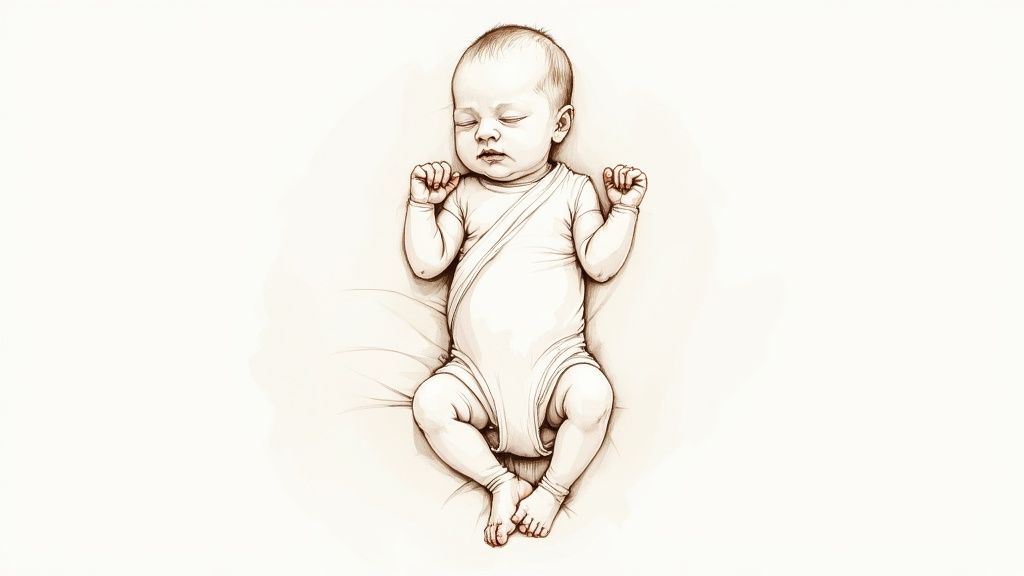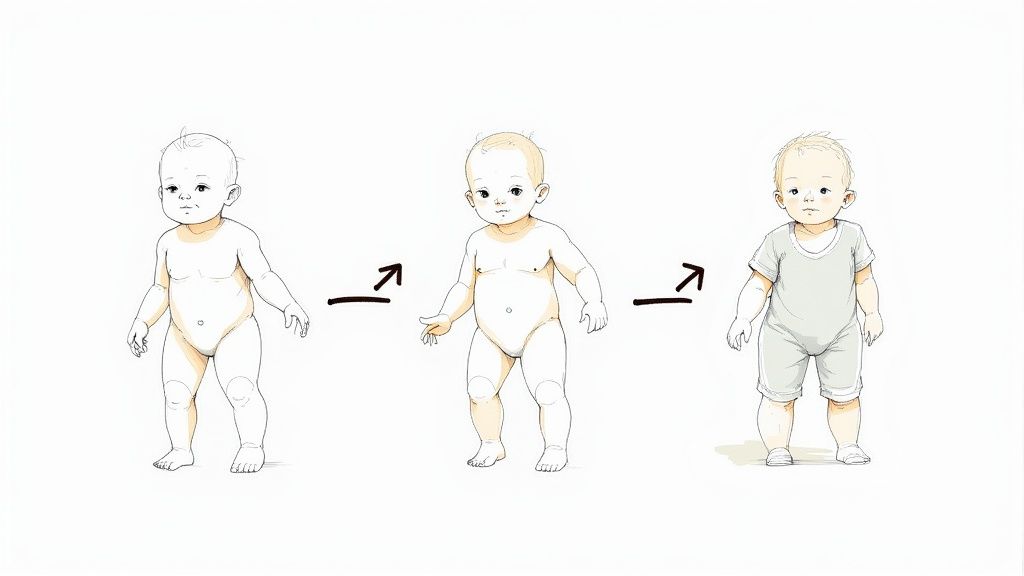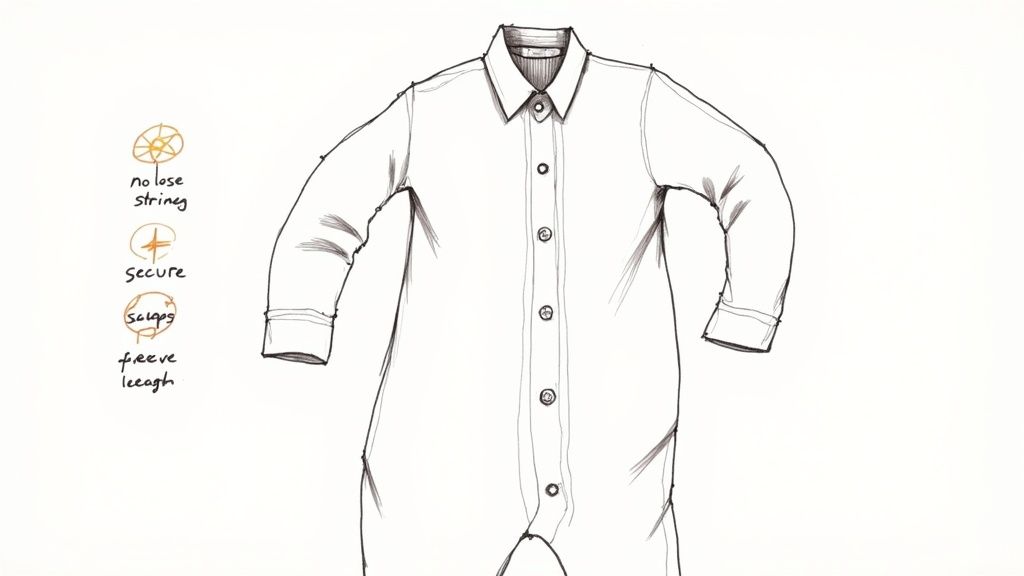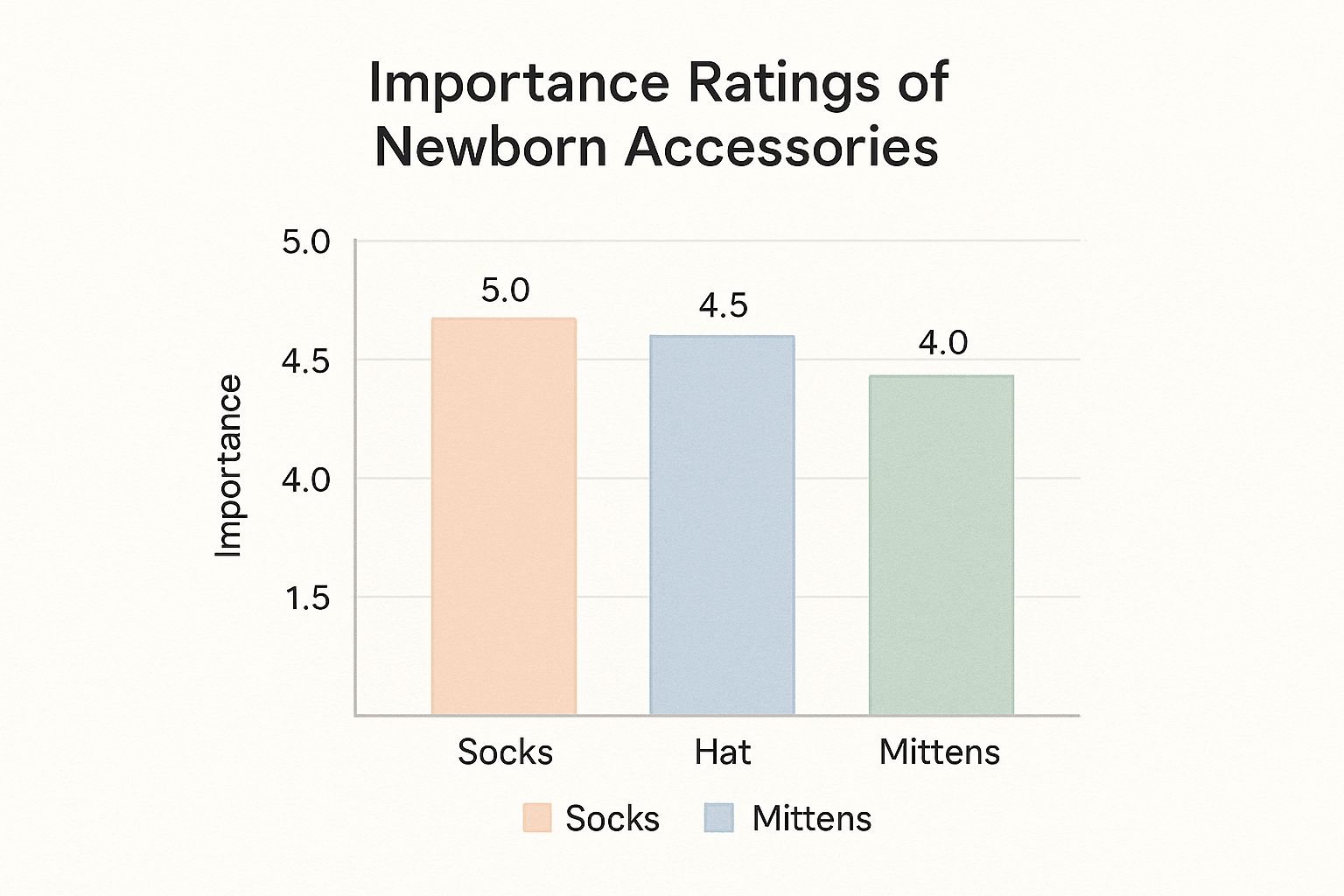Dressing a newborn can feel a bit like guesswork, but there's a golden rule that seasoned parents and midwives swear by, especially with the ever-changing UK weather. Simply dress your baby in one more layer of clothing than you're comfortably wearing yourself. It’s a beautifully simple guideline that cuts through the confusion.
Start with a foundation of soft, breathable cotton, and you’re already on the right track to a happy, cosy baby.
The "One More Layer" Rule of Thumb

When you first bring your little one home, you're bombarded with advice. If you remember just one thing about dressing them, let it be the "one more layer" principle. It's a practical starting point that instantly makes sense.
So, why does this work so well? Newborns, particularly in those first few weeks, haven't quite mastered regulating their own body temperature. They lose heat much faster than we do, so that extra, lightweight cotton layer provides just the right amount of insulation to keep them snug without overheating.
Why Cotton Is King
The real secret to making the layering rule work is choosing the right material for that base layer, and cotton is the undisputed champion. There's a good reason it's the go-to fabric for baby clothes. First and foremost, it’s incredibly soft, which is vital for protecting your baby’s delicate and sensitive skin from irritation.
Even more importantly, cotton is breathable. This is a huge factor in preventing one of the biggest worries for new parents: overheating. When your baby is dressed in layers of pure cotton, they stay warm, but the fabric allows air to circulate freely, wicking away moisture. No clammy, uncomfortable baby here.
Pro Tip: The best way to check if your baby is a comfortable temperature is to feel the back of their neck or their tummy. If it feels warm and dry (not sweaty or cold), you've got it just right. Don't worry if their hands and feet feel a bit cool; that's perfectly normal and not a reliable indicator.
Think of cotton as the building block of your baby's entire wardrobe. Before you get swept up in cute outfits and tiny shoes, stocking up on cotton essentials ensures that every outfit starts with comfort and safety.
To get started, here’s a quick look at the essential cotton items every new parent in the UK should have on hand.
Your Newborn's Core Cotton Wardrobe
| Clothing Item | Primary Material | Key Function |
|---|---|---|
| Vests/Bodysuits | 100% Cotton | The perfect base layer. Keeps the core warm and nappies in place. |
| Sleepsuits/Babygrows | 100% Cotton | All-in-one outfits for sleep and play. Easy and practical. |
| Hats | Soft Cotton | Crucial for newborns to prevent heat loss through their head. |
| Scratch Mitts | Lightweight Cotton | Protects their face from tiny, sharp fingernails. |
| Muslin Squares | Cotton Muslin | The multi-tool: for swaddling, burping, and mopping up spills. |
Building your baby’s wardrobe around these core cotton pieces makes layering simple and keeps your little one comfortable, no matter what the day brings.
Why Cotton is the Gold Standard for Your Baby’s Skin

When you're figuring out how to dress your newborn, it’s not just about how many layers to put on. The fabric you choose is just as crucial. A newborn's skin is unbelievably delicate—it's actually up to 30% thinner than our own, which makes it prone to irritation. This is exactly why cotton is, and has always been, the best friend of your little one's wardrobe.
The natural fibres are beautifully soft, which means less risk of rubbing or chafing against that sensitive skin. But more than that, cotton is wonderfully breathable. It lets air circulate, which is key to helping your baby regulate their body temperature and cuts down the risk of overheating—something every new parent worries about.
Synthetics, on the other hand, can trap heat and moisture right against the skin. Cotton does the opposite; it wicks sweat away, keeping your baby dry and comfortable. This simple quality goes a long way in preventing things like heat rash or eczema flare-ups.
Making Sense of Cotton Labels
Once you start shopping, you’ll notice a few different labels on cotton clothing. Standard cotton is always a solid choice, but knowing what the other labels mean can help you pick what feels right for your family.
- Organic Cotton: This means the cotton was grown without any synthetic pesticides or fertilisers. It’s a kinder choice for your baby and for the planet.
- GOTS-Certified Organic Cotton: This is the top tier. GOTS certification doesn't just guarantee the cotton is organic; it ensures the entire production line, from the field to the finished garment, meets strict social and environmental standards.
This shift towards safer, more sustainable options is something we're seeing more and more. In fact, about 30% of UK parents are now actively choosing baby clothes that are non-toxic and sustainably made. You can find more fantastic, gentle options in our guide to the best unisex baby clothes.
Choosing high-quality cotton is an investment in your baby's daily comfort. A soft, breathable outfit provides a soothing environment against their skin, making them feel secure and settled throughout the day.
This 'gentle-on-the-skin' thinking should extend beyond just clothes. When it comes to bath time, for instance, a mild product like Live Clean Baby Soothing Oatmeal Relief Tearless Baby Wash works in harmony with soft cotton pyjamas to keep your baby's skin calm and happy.
Mastering Layers for Unpredictable UK Weather

Ah, classic British weather. Sunshine, showers, and a brisk wind all before lunchtime. As a new parent, you quickly learn that layering your newborn’s clothes isn't just a good idea—it's an essential survival skill. The real goal is to keep your little one at a stable, comfortable temperature, and that means being ready to adapt at a moment's notice.
Think of cotton layers as your toolkit for comfort. Popping from a warm car into a chilly supermarket is a perfect example. A light, cellular cotton blanket or a simple zip-up cotton cardigan can be whipped on or off in seconds, often without even waking a sleeping baby. It’s this adaptability that makes layering a game-changer.
You're not alone in thinking this way. UK search trends show parents are always planning ahead. Searches for "newborn baby outfits" often peak in February for spring arrivals, and as summer hints at an appearance, searches for "newborn summer clothes" can jump by as much as 34%. It's clear that the seasons dictate how we all approach our little ones' wardrobes. If you're curious, you can see more about how UK parents are preparing on Accio.com.
A Seasonal Guide to Layering
When the cold really sets in during winter, having a reliable system makes all the difference. I always found it best to start with a soft, short-sleeved cotton vest right against the skin. Then, pop a long-sleeved cotton sleepsuit over the top. For heading outdoors, a padded pramsuit or a thick blanket is that final, cosy barrier against the chill.
Parenting Tip: A quick but vital word on car seat safety. Be very careful with bulky pramsuits in car seats. Thick padding can create a dangerous gap between your baby and the harness, making it less effective in an accident. Always make sure the straps are snug against their body, not the puffy suit.
Come summertime, the rule is simple: less is more. On properly hot days, a single layer of lightweight cotton is often all they need. A short-sleeved cotton vest or a simple romper is perfect. And don’t forget a wide-brimmed cotton sun hat to shield their delicate face and neck.
Spring and autumn are the trickiest, demanding the most flexibility. These are the seasons of "just in case" layers. A long-sleeved cotton vest and leggings with a light cotton cardigan is a brilliant starting point. You can easily slip the cardigan off if the sun makes a surprise appearance or add a light blanket if a cloud brings a sudden chill. It’s all about staying one step ahead of our famously fickle weather.
Choosing the Right Sleepwear for Safe Nights
Getting your newborn dressed for bed is one of those early parenting tasks where comfort and safety are completely intertwined. You've probably heard the most important rule for safe sleep a dozen times: keep the cot clear. That means no loose blankets, duvets, or pillows. This is exactly why baby sleeping bags, made from breathable cotton, are an absolute game-changer for new parents.
Think of them as wearable blankets. They keep your little one snug and at a consistent temperature all night long. No more worrying about them kicking off the covers and waking up cold, or the far more serious risk of wriggling underneath them. Most are made from beautifully soft, breathable cotton, so they're lovely and gentle on delicate skin. Honestly, when you're trying to figure out what a newborn should wear at night, a good cotton sleeping bag removes all the guesswork.
Getting to Grips with TOG Ratings
The secret to using a sleeping bag safely is understanding the TOG (Thermal Overall Grade) rating. It sounds technical, but it’s just a simple measure of how warm the fabric is. A higher TOG rating means a warmer bag for cooler rooms, and a lower TOG is for when it's a bit balmy.
Getting this right is so important because it helps prevent your baby from overheating, which is a known risk factor we all want to avoid.
Here's a quick reference I've always found useful for matching the sleeping bag to the room's temperature. It's much easier than you think!
| Guide to Sleeping Bag TOGs and Room Temperatures | | :--- | :--- | :--- | | Room Temperature (Celsius) | Recommended TOG Rating | What to Wear Underneath | | Above 24°C (Heatwave) | 0.5 TOG | Just a nappy, or a short-sleeved cotton vest if needed. | | 20-24°C (Summer/Warm Room) | 1.0 TOG | A short-sleeved or long-sleeved cotton vest. | | 16-20°C (All Year) | 2.5 TOG | A long-sleeved cotton sleepsuit (or 'babygrow'). | | Below 16°C (Cold Snap) | 3.5 TOG | A long-sleeved cotton sleepsuit and a cotton vest underneath. |
This table should give you the confidence to pick the right combination, ensuring your baby is always comfortable and, most importantly, safe while they sleep.
Of course, dressing for sleep isn't just about the main layer. Little things like socks and hats matter too, as you can see from what other UK parents think.

It's clear from the data that while parents value hats and mittens, keeping those tiny feet warm with socks is a real priority, even for bedtime.
Practical Clothing Features That Make Life Easier
When you're trying to dress a wriggly newborn at 3 a.m., practicality trumps style every single time. As any experienced parent will tell you, the clever, parent-friendly features on a cotton babygrow are what you'll really appreciate. They can genuinely reduce stress during nappy changes and dressing sessions.
The design of a garment makes all the difference. It’s those simple, thoughtful details that separate an outfit you reach for daily from one that gathers dust at the back of the drawer, no matter how cute it looks.
Look For Features That Save Time and Tears
Think convenience first. Front-facing poppers are infinitely easier to manage than tiny buttons running down the back, especially when your baby is lying down. You really don't want to be flipping a tiny, delicate baby over just to get them dressed.
Another absolute lifesaver is the envelope neckline you see on most cotton bodysuits and vests. This isn't just a design choice; it allows you to pull the garment down over your baby's shoulders and body instead of wrestling it over their head. It's a true game-changer after a particularly messy nappy leak.
Parenting Insight: Two-way zips on cotton sleepsuits are a non-negotiable for those middle-of-the-night changes. Being able to zip up from the bottom to access the nappy, all while keeping your baby's chest and arms warm and cosy, is a small detail that feels like a huge win.
Always put their comfort and safety ahead of complicated designs. It's best to steer clear of outfits with lots of fiddly buttons, tight necklines, or decorative bits like ribbons that could pose a safety risk.
Preparation is Key
Before your baby wears anything new, it's essential to wash it first. Always use a gentle, non-bio detergent to remove any residues from the manufacturing and shipping process that might irritate their very delicate skin.
It’s also wise to think about sizing. Babies grow astonishingly fast, so buying clothes that are slightly larger is often a smarter, more economical choice. This approach not only gives you better value for money but also ties into a more sustainable mindset by reducing the need for constant replacements. Understanding the impact of our clothing choices is crucial, and you can learn more about what fast fashion is and how to make more conscious decisions.
A snug fit can be restrictive, but a little extra room gives them space to move and grow comfortably.
Building Your Newborn’s First Wardrobe
Putting together a wardrobe for your new baby doesn’t need to be a huge, expensive task. The real secret is to think small and smart. You’re aiming for a capsule collection of basics that are versatile, comfortable, and easy to coordinate. Try to resist those adorable but impractical impulse buys and stick to high-quality cotton essentials that will be the workhorses of your baby’s daily outfits.
When you're figuring out how to dress a newborn, you’ll quickly learn that less is absolutely more. A minimalist mindset not only saves you money but also cuts down on the never-ending laundry pile. I always recommend sticking to a simple, calming colour palette. This makes mixing and matching effortless, so you can get your little one dressed in a flash, whatever the day holds.
The Must-Have Essentials
To get started, let’s focus on the pieces you’ll reach for every single day. Here’s a tried-and-tested checklist built around cotton:
- 7-8 Cotton Sleepsuits: These all-in-ones (often called babygrows) will be your uniform for both daytime and nighttime. Trust me.
- 7-8 Cotton Vests: These are the bodysuits that go underneath everything. Whether short or long-sleeved, they provide that crucial base layer of warmth.
- 2-3 Cotton Cardigans: Living in the UK, you know how quickly the temperature can change. A couple of simple cotton cardigans are perfect for quickly adding or removing a layer.
- 2 Cotton Hats: Essential for newborns when you’re out and about, as they lose a lot of heat through their heads.
- 5-6 Pairs of Socks: To keep those tiny toes toasty.
This focus on practical, essential baby clothing isn't just a parenting hack; it's a wider trend. The UK baby clothes market is set for steady growth, with projections showing a +2.7% increase each year through 2035. This just highlights how much parents continue to prioritise safe and comfortable clothing for their little ones. You can dive deeper into these market insights over at IndexBox.io.
A little tip from experience: newborns grow astonishingly fast. It’s almost always a good idea to buy the '0-3 months' size instead of 'newborn', as they might only fit into the smaller size for a couple of weeks. I always had one or two 'next size up' sleepsuits washed and ready to go – you’ll be glad you did when a sudden growth spurt hits
It's completely normal to have a million questions when you're figuring out how to dress your tiny newborn. Let's walk through some of the most common queries I hear from new parents.
Should My Newborn Wear a Hat Indoors?
This is a big one. While a soft, snug cotton hat is essential for keeping your baby warm when you’re out and about, you should take it off as soon as you come inside.
A baby's head is a key area for releasing heat, and overheating is a real concern. As long as your home is a comfortable, stable temperature, your little one will be perfectly fine without a hat indoors.
How Do I Know If My Baby Is Too Hot or Cold?
It’s tempting to feel their little hands or feet, but they often feel cooler than the rest of their body, so they aren't the most reliable guide.
The best place to check your baby's temperature is the back of their neck or their chest. If their skin feels hot or sweaty, they're too warm and it's time to remove a layer. If it feels a bit cool, you might want to add a light layer, like a simple cotton cardigan.
This little trick gives you a much more accurate sense of their core temperature and comfort.
How Many Outfits Will My Newborn Actually Go Through in a Day?
From experience, I'd say plan for at least two to three full outfit changes every single day. Maybe even more on a particularly eventful day!
Between spit-up, milk dribbles, and the inevitable nappy leaks, you’ll be surprised how quickly you get through those adorable outfits. Having a good stock of soft cotton sleepsuits and vests ready to go makes those quick changes so much less stressful.
At Little Novice, we create timeless, high-quality cotton essentials that are gentle on your baby's skin and the planet. Explore our collection of beautifully made, sustainable pieces. Shop the collection at Little Novice.